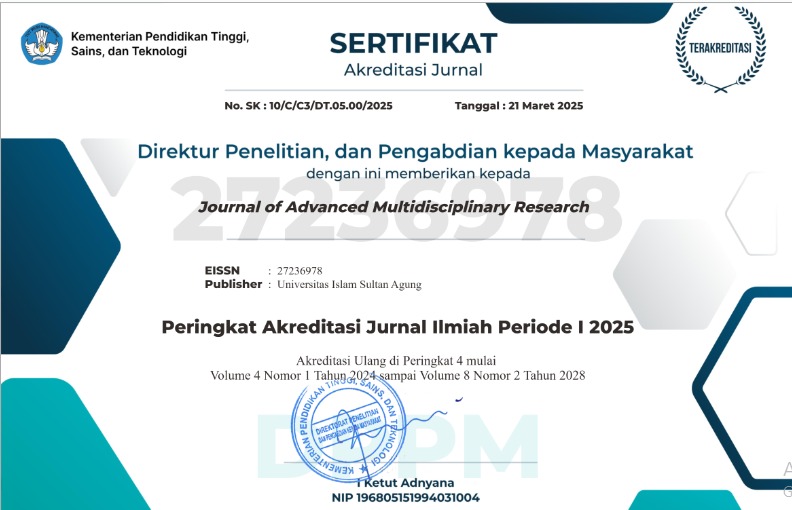The Effect of Combination of Core Stability Training and Lower Extremity Strength Training on Static Standing Balance Ability in a Child with Down Syndrome
Abstract
Keywords
Full Text:
PDFReferences
Agarwal Gupta, N., & Kabra, M. (2014). Diagnosis and management of Down syndrome. Indian Journal of Pediatrics, 81(6), 560–567. https://doi.org/10.1007/s12098-013-1249-7
Aly, S., & Abonour, A. (2016). Effect of core stability exercise on postural stability in children with Down syndrome. In Article in International Journal of Medical Research & Health Sciences. www.ijmrhs.com
Arumugam, A., Raja, K., Venugopalan, M., Chandrasekaran, B., Kovanur Sampath, K., Muthusamy, H., & Shanmugam, N. (2016). Down syndrome—A narrative review with a focus on anatomical features. In Clinical Anatomy (Vol. 29, Issue 5, pp. 568–577). John Wiley and Sons Inc. https://doi.org/10.1002/ca.22672
Eid, M. A. (2015). Effect of Whole-Body Vibration Training on Standing Balance and Muscle Strength in Children with Down Syndrome. American Journal of Physical Medicine and Rehabilitation, 94(8), 633–643. https://doi.org/10.1097/PHM.0000000000000224
Endo, Y., Kanai, Y., Yozu, A., Kobayashi, Y., Fukaya, T., & Mutsuzaki, H. (2020). Influence of a foot insole for a down syndrome patient with a flat foot: A case study. Medicina (Lithuania), 56(5). https://doi.org/10.3390/medicina56050219
Hussein, Z. A. (2017). Strength training versus chest physical therapy on pulmonary functions in children with Down syndrome. Egyptian Journal of Medical Human Genetics, 18(1), 35–39. https://doi.org/10.1016/j.ejmhg.2016.02.008
Lin, H. C., & Wuang, Y. P. (2012). Strength and agility training in adolescents with Down syndrome: A randomized controlled trial. Research in Developmental Disabilities, 33(6), 2236–2244. https://doi.org/10.1016/j.ridd.2012.06.017
Ludwig, O., Kelm, J., Hammes, A., Schmitt, E., & Fröhlich, M. (2020). Neuromuscular performance of balance and posture control in childhood and adolescence. Heliyon, 6(7). https://doi.org/10.1016/j.heliyon.2020.e04541
Marano, M., Pompucci, A., Motolese, F., Rossi, M., Coletta, E., di Lazzaro, V., Fasano, A., & Petrella, G. (2020). Normal Pressure Hydrocephalus in down Syndrome: The Report of Two Cases. Journal of Alzheimer’s Disease, 77(3), 979–984. https://doi.org/10.3233/JAD-200409
Mercer, V. S., & Lewis, C. L. (2001). Hip Abductor and Knee Extensor Muscle Strength of Children with and without Down Syndrome. https://journals.lww.com/pedpt
Pollock, A. S., Durward, B. R., Rowe, P. J., & Paul, J. P. (2000). What is balance? Clinical Rehabilitation, 14(4), 402–406. https://doi.org/10.1191/0269215500cr342oa
Saeed, R., Mohamed, A., & Elshafey, A. (2019). Effect of Core Stability Exercises and Treadmill Training on Balance in Children with Down Syndrome: Randomized Controlled Trial. Advances in Therapy, 5(1). https://doi.org/10.6084/m9.figshare.8325431
Villarroya, M. A., González-Agüero, A., Moros-GarcÃa, T., de la Flor MarÃn, M., Moreno, L. A., & Casajús, J. A. (2012). Static standing balance in adolescents with Down syndrome. Research in Developmental Disabilities, 33(4), 1294–1300. https://doi.org/10.1016/j.ridd.2012.02.017
Wang, H. Y., Long, I. M., & Liu, M. F. (2012). Relationships between task-oriented postural control and motor ability in children and adolescents with Down syndrome. Research in Developmental Disabilities, 33(6), 1792–1798. https://doi.org/10.1016/j.ridd.2012.05.002
Wu, J., Beerse, M., Ajisafe, T., & Liang, H. (2015). Walking dynamics in preadolescents with and without down syndrome. Physical Therapy, 95(5), 740–749. https://doi.org/10.2522/ptj.20140210
Zulfiqar, H., Hafiz Muneeb Ur Rehman, Razzaq, A., Zaib Un Nisa, Maryam Hina, Bashir, H., Saeed, H., & Ashraf, N. us S. (2022). Effect Of Core Stability Exercises and Balance Training in Postural Control Among Children with Down Syndrome. Pakistan BioMedical Journal, 18–22. https://doi.org/10.54393/pbmj.v5i7.392
DOI: https://dx.doi.org/10.30659/jamr.3.2.71-78
Refbacks
- There are currently no refbacks.
Copyright (c) 2022 Adelia Rahmayanti, Farid Rahman, Intan Herlinawati
Journal of Advanced Multidisciplinary Research (JAMR) is published by Research and Community Service Department (LPPM) Universitas Islam Sultan Agung Semarang, Indonesia.
Address: Jl. Kaligawe Raya Km. 4 Semarang, Indonesia.





